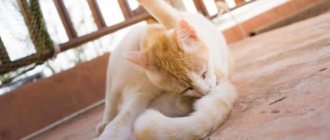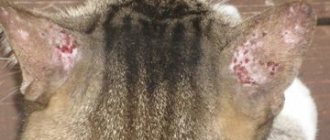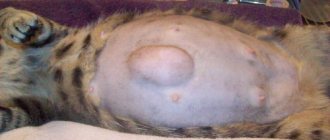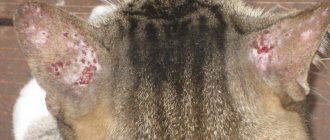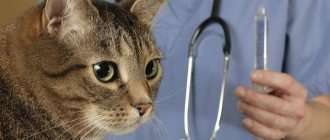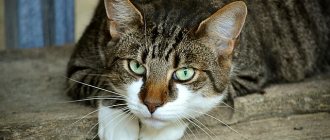“At what age should baby teeth be removed from dogs and cats?.. Do they need to be removed?.. Can they be left?.. Will they fall out on their own?.. Are baby teeth removed from dogs and cats with or without anesthesia?.. What’s worse is anesthesia or remaining baby teeth teeth?.."
These questions are asked by every puppy or kitten owner.
Let's try to figure it out...
Changing baby teeth to permanent ones in a cat.
Indications: when is it required?
This procedure is performed for chronic diseases of the oral cavity. Removing teeth from a cat makes it possible to avoid complications of the disease. The main indications for the operation are:
- periodontitis;
- crowded teeth;
- broken fangs;
- deformation of the entire dentition;
- odontoclastic lesions of the oral cavity;
- root resorption;
- tartar;
- milk teeth that did not fall out on time;
- stomatitis.
Lack of teeth. Is it harmful for cats?
Not all owners take proper care of their pets. It happens that veterinarians have to remove teeth because treatment is simply useless. Of course, complete absence of teeth can be frightening for a cat owner. It seems that it will be very difficult for the pet to eat, and starvation is already close. In fact, the situation is not as hopeless as it might seem at first glance.
In nature, felines need teeth to perform a lethal chokehold on their prey. They do not use them to chew food. They need their teeth in order to tear their prey to shreds and then simply swallow the piece whole. A cat’s digestive system is designed in such a way that it can digest food just fine.
Modern ready-made cat food is soft, so even without teeth the pet will easily get enough. Domestic cats do not need to hunt. Food is delivered “to your home”. But, despite the fact that the toothless cats are threatening me with starvation, it’s not worth letting the situation get to that extent.
Preparation for the operation
Before such a procedure, the doctor checks the animal’s blood pressure.
Initially, you must consult a veterinarian who will measure your pulse, blood pressure and body temperature. Palpation and percussion of the pet and a full examination of the oral cavity are also carried out. Ultrasound examination is considered an important procedure for identifying hidden forms of pathology of internal organs. It is recommended to submit urine and blood for clinical analysis and biochemistry.
The veterinarian will recommend that the animal owner consult a cardiologist to identify problems with the cardiovascular system in order to avoid negative consequences from anesthesia.
Anesthesia before surgery
Anesthesia is considered a prerequisite for the procedure. The painkiller is injected into a vein in the animal, usually in the back leg. Before giving such an injection, the pet's fur in this area is shaved clean. If necessary, during the operation the doctor may prescribe emergency additional anesthesia with a special gas, for which a cone-shaped mask is used. It is important not to overdo it with anesthesia, especially for older cats and those with heart problems. For successful tooth extraction surgery, it is recommended to keep the cat without food for up to 10 hours. Otherwise, due to the administration of painkillers, nausea and vomiting may occur.
Technique: main points
The actual removal of the bone process is carried out using special tweezers.
After thorough preparatory procedures for all teeth, the animal’s oral cavity is washed with an antiseptic. The yawner is then inserted and the tongue is removed manually. The gums and mouth are lubricated with iodine, then an incision is made with a medical scalpel, after which the diseased tooth is sharply loosened in different directions with forceps and pulled out. Canines and molars are the most difficult to remove. Bleeding often occurs during surgery but stops using conventional methods. To do their work, dentists use articulated forceps, they grab the tooth root, shake it with smooth movements and, when the hinge rests on a healthy tooth nearby, press the handle of the instrument towards the opposite jaw. After this, the affected incisor is easily removed from the oral cavity.
There are cases when the extreme molar does not lend itself to such a procedure and must be knocked out. This is the most difficult dental surgery for cats. To carry it out, trepanation of the jaw of the upper sinus is performed. A round chisel is inserted through the resulting hole and, with short, gentle blows of a special hammer, the diseased tooth is knocked out from the alveolus, only after which is it possible to remove it with forceps. After the procedure, the oral cavity is treated with a solution of potassium permanganate and water, always maintaining a ratio of 1:500, for which sterile swabs and clamps are used.
The veterinarian offers high-quality dental extraction services for cats and also provides assistance to owners with pet oral care.
Physiological reasons
Sometimes tooth loss is considered normal.
Count lost teeth and take proper care of your kitten to alleviate its condition. There may be complications in the process. Often the molars can grow when the primary canines have not yet fallen out. Instead of 4 bone elements, the animal temporarily has 5-8.
In older cats, vitality decreases and the body's strength begins to decline. Changes also affect the dental system. An animal is considered aging after 7-8 years. It is not necessary that the cat will remain toothless after this age.
Some pets remain active even after 10 years. However, such a phenomenon is possible and is considered physiological.
How to help your pet
To make your pet's life easier, you need to properly care for it. The kitten should be taught to brush its teeth. When changing bone elements, the animal will happily scratch its itchy gums with the brush. Carry out the procedure at least 1-2 times a month.
Avoid solid foods. Hard granules can injure the oral cavity. Choose food with a soft consistency. To feed kittens, you should use special products for cubs. The ratio of proteins, fats, carbohydrates, and vitamins in it differs from what adult cats need.
It is recommended to treat the oral cavity with Chlorhexidine. This measure will help prevent infection and the development of life-threatening complications for the animal.
Consequences
Your pet may remain lethargic for some time after the procedure.
After surgery to remove teeth, a cat may feel worse and may experience nausea and vomiting. Weakness, lethargy, apathy, and lack of appetite appear. Swelling of the gums for 1-2 days is considered normal; for this reason, the dentist prescribes antibiotics in the form of intramuscular injections. If you ignore this and start the condition, an abscess may occur - a total inflammatory disease of the oral cavity.
Have you changed?
So, we know why a cat loses teeth before the age of one year. But how can you tell if your teeth have changed? Temporary teeth are very easy to distinguish from permanent teeth. They will be much sharper, with a curved shape. At the point of contact with the gum they are very thin. If you see not four, but eight teeth, then you shouldn’t worry at first.
You should watch the animal. If the teeth do not change on their own, the kitten will have to be helped. This should be done by a specialist. You cannot remove an old tooth at home. In addition, an experienced and qualified doctor can determine the pathology and can explain why the cat’s teeth fall out at 2 or 3 years old. The veterinarian will also help correct the kitten’s malocclusion.
Rehabilitation
The first day after surgery is considered the most critical in recovery. At this time, it is recommended to carefully monitor the pet’s condition and not leave it unattended. The first thing you need to do when you get home is to put the cat on the floor in a secluded place where there are no drafts or heaters. You cannot put an animal on the bed, as it may fall and get injured. Proper rehabilitation allows you to feed the cat only after complete recovery from anesthesia. You need to start with a light semi-liquid warm meal.
As soon as the animal wakes up, water is given from a pipette to moisten the mucous membrane, and so on every half hour. It is important to ensure that the pet does not start drinking from the owner’s cup or his own bowl on his own, as he may choke while signs of anesthesia are still present. It is necessary to place the cat's litter box next to the place where he rests. Every hour it is recommended to measure body temperature, measure heart rate, and examine the mucous membranes of the eyelids and oral cavity. After tooth extraction, it may be necessary to administer special injections and treat sutures in the mouth.
Pathological changes in adult cats
If your cat loses a tooth as an adult, you should take your pet to a veterinarian. A similar phenomenon is observed in dental pathologies.
READ What causes a cat to vomit blood?
The clinical picture may vary depending on the pathology observed. Loss may be due to injury. In such a situation, at home, it is enough to treat the wound with an antiseptic solution to prevent the entry of pathogenic bacteria. The wound will heal on its own.
Briefly about treatment
The treatment regimen depends on the age, disease, and individual characteristics of the animal. It is impossible to restore a lost tooth. The goal of therapy is to prevent new losses and deterioration of the pet’s condition.
You will have to change the cat's diet. Special medicinal feeds are prescribed. To prevent the occurrence of new mechanical damage, you will have to choose soft, liquid ones. Additional intake of vitamin and mineral complexes may be required. This is especially important for cats that eat natural foods. They may not receive enough nutrients from food.
If there is tartar, the clinic performs a procedure to remove it under general anesthesia. Premedication is used to block vagal reflexes. The cat remains conscious, but is not able to resist or harm the doctor or himself. Since the operation will be stressful for the cat, after recovering from anesthesia, keep her calm and do not allow children or other animals near the pet.
At the same time, medications are prescribed to strengthen the gums and get rid of bleeding that has begun. You may need to take antibiotics if you have a bacterial illness. In some situations, it is necessary to adjust the treatment regimen for another pathology, change the drug or reduce the dosage.
If your gums are inflamed, dental gels are most often prescribed. You can buy them in pharmacies. Such products are designed for people, but also help animals. The drug must be selected by a veterinarian; self-medication is unacceptable. Squeeze a small amount of gel onto your finger, then rub into the affected gum with light circular movements.
To prevent pathology, brush your pet's teeth regularly. Use special pastes for cats. Human cats are not suitable. To prevent the formation of tartar, allow the animal to chew on special toys.
You can use medicinal food and cleaning sticks. Change your diet if necessary, select the appropriate vitamins. With food, the pet must receive all the substances it needs. Treat against parasites in a timely manner.
READ What to feed titmouse fill the feeder
At the first sign of oral health problems, contact your veterinarian. Carry out regular preventive examinations to detect problems before canines and incisors begin to fall out.
Further forecast
If treatment is started in a timely manner, the loss of new teeth can be avoided. You can install an implant in your cat. However, such an operation will be stressful for the pet. In addition, you will have to pay a large sum for installing an artificial tooth.
Sincerely, Pelageya Egorovna
